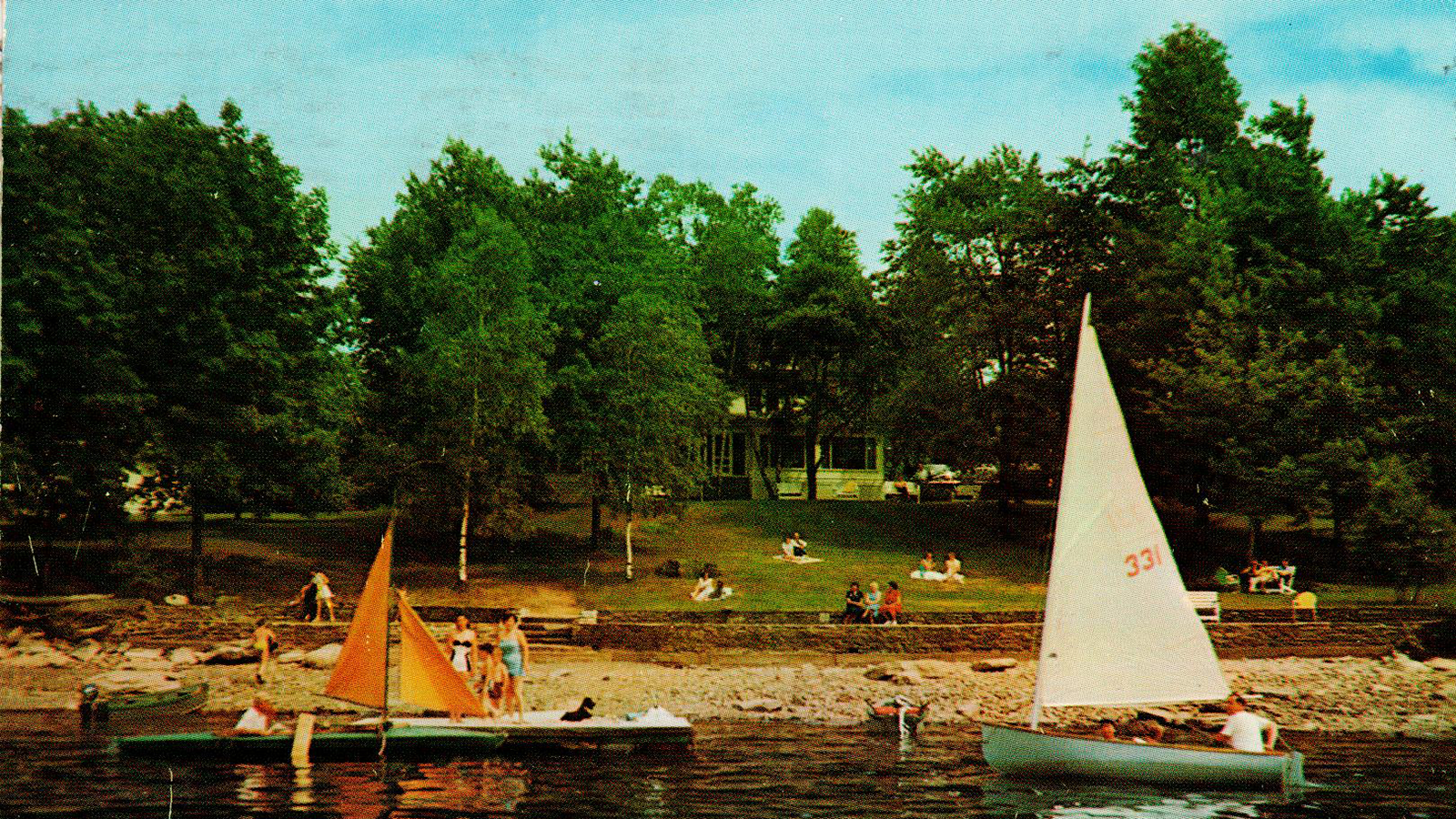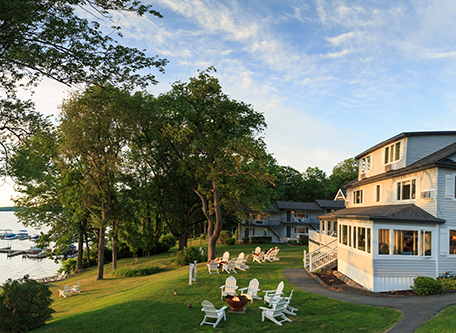Receive for Free - Discover & Explore eNewsletter monthly with advance notice of special offers, packages, and insider savings from 10% - 30% off Best Available Rates at selected hotels.
history of silver birches' hawley, pa hotel
Discover the Silver Birches with its family tradition of management.
Silver Birches, a member of Historic Hotels of America since 2016, dates back to 1929.
VIEW TIMELINESilver Birches is among the most historic hotels near Poconos Mountains, PA. Its origins harken back to that of George and Rachel Singer, who constructed the facility as a quaint homestead in 1904. The couple operated the farm for the next two decades until they were faced with a difficult decision. In the early 1920s, the Pennsylvania Power & Light Company approached the two with the offer to purchase most of their farm for use in a massive infrastructural project. The PP&L specifically wanted to create a 13-mile-long lake out of the local watershed, in order to supply the region with a reliable source of hydroelectric power. The couple consented to sell the land, which was then flooded to help make today’s Lake Wallenpaupack. Realizing the value of their newly created waterfront property, the Singers decided to transform what remained of their homestead into a quaint, 14-room inn. Officially opened in 1929, the inn quickly made a name for itself by providing only the best in-country hospitality. The family offered generous room and board, as well as three home-cooked meals a day—a rarity for businesses of that size!
Lake Wallenpaupack proved to be a blessing in disguise, though, becoming the primary force that fueled the local economy. Local tourism flourished, as people were enchanted by the lake’s tranquil majesty. Sensing a huge financial opportunity, the Chamber of Commerce in nearby Hawley soon coordinated with the area’s entrepreneurs to further incentivize travel to the region. A number of hotels and resorts popped up, as such, transforming Lake Wallenpaupack into an exclusive getaway. Among the endeavors that the Chamber pursued was the founding of “Settlers Inn,” which would later go on to become the sibling of Silver Birches (as well as another member of Historic Hotels of America). Having been in operation for several years, the Singers, fortunately, had a leg up on the competition. They used their economic advantages to expand the family portfolio, partnering with their relatives to open a second facility known as “Pep’s Inn” off Route 507. But George had also founded a logging company that had become quite prosperous. Concerned, Rachel Singer hired her sister, Marjorie Ehrhardt, to assist in managing Silver Birches.
In 1943, Marjorie and her husband, George, purchased the inn from the Singers. They immediately enlarged the structure, converting the farmhouse and barn into a sprawling resort complex. The Ehrhardt's soon recruited their only son, Jerry, and his wife, Alice, to support the venture. Their involvement secured the resort’s future as a family-run enterprise for years to come. Under Ehrhardt’s watch, Silver Birches continued to grow in popularity throughout the mid-20th century. Lake Wallenpaupack itself had undergone its own transformation, as new cottages and summer homes began to line its coast. As such, the Ehrhardt's expanded the facility once more, installing additional guestrooms and cottages onto the grounds in 1966. Jerry and Alice eventually called upon their own children—Eric, Steve, and Craig—to help out. All three boys had grown up at Silver Birches and had a deep love for the destination. Formally trained in modern hospitality, the men saw the resort’s successful transition into the 21st century. They bought the Marine Terrace next door and added Ehrhardt’s Lakeside Restaurant, too. And in 1995, the three installed the Waterfront Banquet Center for large weddings.
By 2015, three generations of Ehrhardt's had managed Silver Birches. But budding rivalries from new commercial developments around Lake Wallenpaupack caused the Ehrhardt family to further adapt. For the sake of the business’ longevity, Eric Ehrhardt created a plan with the Genzlinger family to acquire Silver Birches. Eric—and the rest of the Ehrhardt family—deeply trusted the Genzlingers for their zeal toward historic preservation. The Genzlingers initiated their own extensive renovation of the site, which restored much of the brilliant historical architecture that the Singers first installed. They even added a few new facilities and relaunched the resort’s restaurant as “The Dock.” The Erhardt family remained in touch throughout the whole process, though, providing much need consulting work to aid in the restoration process. As such, Silver Birches maintains its status today as the gem in Lake Wallenpaupack’s crown and a treasure when it comes to Hawley, PA hotels. The resort also continues to exude the same warm, familial charm that defined it when it first opened all those years ago.
-
About the Location +
Silver Birches resides along the shore of Lake Wallenpaupack on the eastern end of Pennsylvania’s Pocono Mountains. Extending for some 13 miles in length, it specifically straddles the border between Wayne and Pike Counties. Its primary outlet is the Lackawaxen River, which serves as a tributary to the much larger Delaware. The land upon which the lake currently resides was once inhabited by the Lenape Indians, who called the area “Wahlinkpapeck” or “deep and dark.” The name specifically referred to the densely forested geography that lined the creek that twisted through the area. English settlers later anglicized the name to “Wallenpaupack” when they arrived in the late-18th century, interpreting it to mean, “the stream of swift and slow water.” The largest landowner soon became James Wilson, who was one of the signatories for both the Declaration of Independence and the United States Constitution. A small village quickly developed at the end of the century within Wilson’s landholdings, which the citizens called “Wilsonville.” A number of other communities subsequently emerged throughout the 1800s, including the likes of Hawley, Paupack, and Palmyra.
Then, in the 20th century, the Pennsylvania Power & Light Company (PP&L) decided to transform Wallenpaupack Creek into a massive lake. The company specifically hoped that the body of water would provide the region with a reliable source of hydroelectric power. The project took some 2,700 men to complete and lasted for nearly two years, ending in 1926. To create the lake, the PP&L constructed a dam and levee in the vicinity of Wilsonville. It then purchased several hundred acres of land from local residents at a rate of $20 per plot. Many of their homes were left behind and demolished, with just the foundations remaining. Most Wilsonville was even abandoned and submerged when the company finally flooded the area. But people were amazing by the water’s clarity as soon as Lake Wallenpaupack opened. In some cases, visitors reported that they could see straight down to the bottom of the lakebed. Yet, the location quickly became a great source of outdoor recreation, as the entire Pocono region emerged as a prestigious tourist hotspot in the 1960s. Today, the Lake Wallenpaupack Watershed Management District supervises the location on behalf of the people who currently live nearby.
The Poconos themselves are a massive mountain chain that shadows the Delaware River before ending near the Lehigh Valley. Its northern reaches drift into New York, where they link up with the Catskills. Some of the summits in the Poconos are capable of reaching several hundred feet in elevation, with the highest peak measuring some 1,800 feet. People have long inhabited the region, as many Native American societies—including the Lenape, Iroquois, and Shawnee—once called the Poconos home. In 1742, English and German settlers began arriving en masse, although the Dutch had created a few outposts on the fringes of the mountain chain a century prior. Small sustenance farms populated the areas where the land was flat and the soil arable. But the Poconos were soon celebrated regionally for its serene environment. The area, thus, gradually built a reputation as a secluded retreat, with the first hotel opening in 1829. Yet, its true metamorphosis into a major holiday destination did not truly come to fruition until the mid-20th century. World War II heavily spurred this development, as American soldiers returning from overseas took their loved ones up into the mountains for a much needed vacation. Its popularity exploded tenfold once the war ended, with families traveling from all over the nation to enjoy its natural beauty. Since the 1990s, the Poconos have been among the most cherished vacation getaways in all of America, with tens of thousands visiting every year.
-
About the Architecture +
Silver Birches is a collection of 13 historic agricultural structures that mainly date back to the early 1900s. The core of the resort once constituted the family farm of George and Rachel Singer, who decided to transform it into a quaint country inn around 1904. Those original buildings displayed some of the finest Colonial Revival-style architecture in the Poconos. Colonial Revival architecture today is perhaps the most widely used building form in the entire United States. It reached its zenith at the height of the Gilded Age, where countless Americans turned to the aesthetic to celebrate what they feared was America’s disappearing past. The movement came about in the aftermath of the Centennial International Exhibition of 1876, in which people from across the country traveled to Philadelphia, Pennsylvania, to commemorate the American Revolution. Many of the exhibitors chose to display cultural representations of 18th-century America, encouraging millions of people across the country to preserve the nation’s history. Architects were among those inspired, who looked to revitalize the design principles of colonial English and Dutch homes. This gradually gave way to a larger embrace of Georgian and Federal-style architecture, which focused exclusively on the country’s formative years. As such, structures built in the style of Colonial Revival architecture featured such components as pilasters, brickwork, and modest, double-hung windows. Symmetrical designs defined Colonial Revival-style façades, anchored by a central, pedimented front door and simplistic portico. Gable roofs typically topped the buildings, although hipped and gambrel forms were used, as well. This building form remained immensely popular for years until largely petering out in late-20th century. Nevertheless, architects today still rely upon Colonial Revival architecture, using the form to construct all kinds of residential buildings and commercial complexes.
"




































